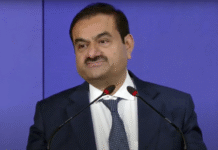New Delhi– India’s annual retail inflation eased by 100 basis points to 5.05 per cent in August, but factory output again dipped to a negative growth of (-)2.4 per cent in July from an expansion of 1.95 per cent in the month before, official data showed on Monday.
The fall in retail inflation, as per data released by the Central Statistics Office (CSO), was thanks to a rather sharp drop in the annual food inflation — from 8.35 per cent in July to 5.91 per cent in August.
As far as the factory output is concerned, the drag was due to a negative growth of (-)3.4 per cent in the manufacturing sub-index, which enjoys the maximum weight in the main index, even as the growth rates in mining and electricity indices were also modest.
In May, the factory output was up 1.1 per cent, while in April it took a hit of (-)1.4 per cent. In July last year, there was a growth of 4.3 per cent. Cumulatively, the growth during the first four months of this fiscal is at (-)0.2 per cent.
This being the last set of data release on retail inflation and industrial production ahead of the next bi-monthly monetary policy update due on October 4, expectations have risen sharply on a possible interest rate cut.
This is also because the annual retail inflation that was above the upper tolerance level of six per cent in July, has since come down by 100 basis points, even though it is still above the base rate of four per cent.
The government target is four per cent plus or minus two percentage points for the next five years.
The Consumer Price Index (CPI) data revealed that the annual retail inflation for rural India was 5.87 per cent, while that for the urban centres was 4.22 per cent.
The annual food inflation was 6.32 per cent in rural areas and 5.10 per cent in the urban conclaves.
The official data further showed that prices of sugar and confectionery edged up by 24.75 per cent on a year-on-year (YoY) basis, whereas cost of pulses was up by 20.01 per cent.
In addition, eggs became expensive by 9.58 per cent, and the cost of spices rose by 8.91 per cent.
Among the states, the retail inflation was lowest in Assam, at 3.39 per cent, followed by Himachal Pradesh at 3.75 per cent, and Uttarakhand at 3.89 per cent. On the flip side, it was as high as 6.69 per cent in Rajasthan, 6.57 per cent in Gujarat and 6.29 per cent in Andhra Pradesh.
The Index of Industrial Production (IIP) data disclosed that among the six use-based classifications of the index, the output of capital goods segment, which is a key indicator of economic activity, declined into the negative territory at (-) 29.6 per cent.
The consumer non-durables segment contracted by (-) 1.7 per cent in July.
However, the consumer durables segment reported a growth of 5.9 per cent, followed by the intermediate goods’ output, which rose by 3.4 per cent.
The basic goods’ output inched up by two per cent.
Overall, 12 out of the 22 industry groups in the manufacturing sector have shown negative growth during the month under review.
Segment-wise, growth was witnessed in ‘tobacco products’ at 22.3 per cent, ‘coke, refined petroleum products and nuclear fuel’ at 12.3 per cent and ‘radio, TV and communication equipment and apparatus’ at 10.9 per cent.
Moreover, high negative growth was reported in the ‘electrical machinery and apparatus’ at (-) 59.2 per cent, ‘medical, precision and optical instruments, watches and clocks’ at (-) 16.8 per cent and ‘wearing apparel; dressing and dyeing of fur’ at (-) 16.2 per cent.
Commenting on the IIP data industry body Ficci’s (Federation of Indian Chambers of Commerce and Industry) President Harshavardhan Neotia said: “The fall in manufacturing growth is indeed disturbing and against our expectations.”
“We were hoping, if not high, some moderate growth in manufacturing in the second quarter of this fiscal which looks difficult now. Investment demand remains an area of concern as reflected in the steep decline of capital goods sector.”
Neotia added: “Weak consumer demand and investments continue to shroud the growth of manufacturing and calls for sustained efforts to address the structural issues that impact manufacturing sector.”
Another industry body PHD Chamber of Commerce and Industry said that negative growth of IIP is a major cause of concern as it indicates subdued pace of investments in the economy.
“However, the growth of consumer durables at 5.9% is encouraging in anticipation of bumper kharif crops vis-à-vis good monsoon scenario. We believe there is a need to push domestic demand particularly the rural demand in the economy,” said Mahesh Gupta, President, PHD Chamber of Commerce and Industry.
“We look forward to calibrated policy measures from the RBI (Reserve Bank of India) in terms of reduction in the policy rates.” (IANS)






